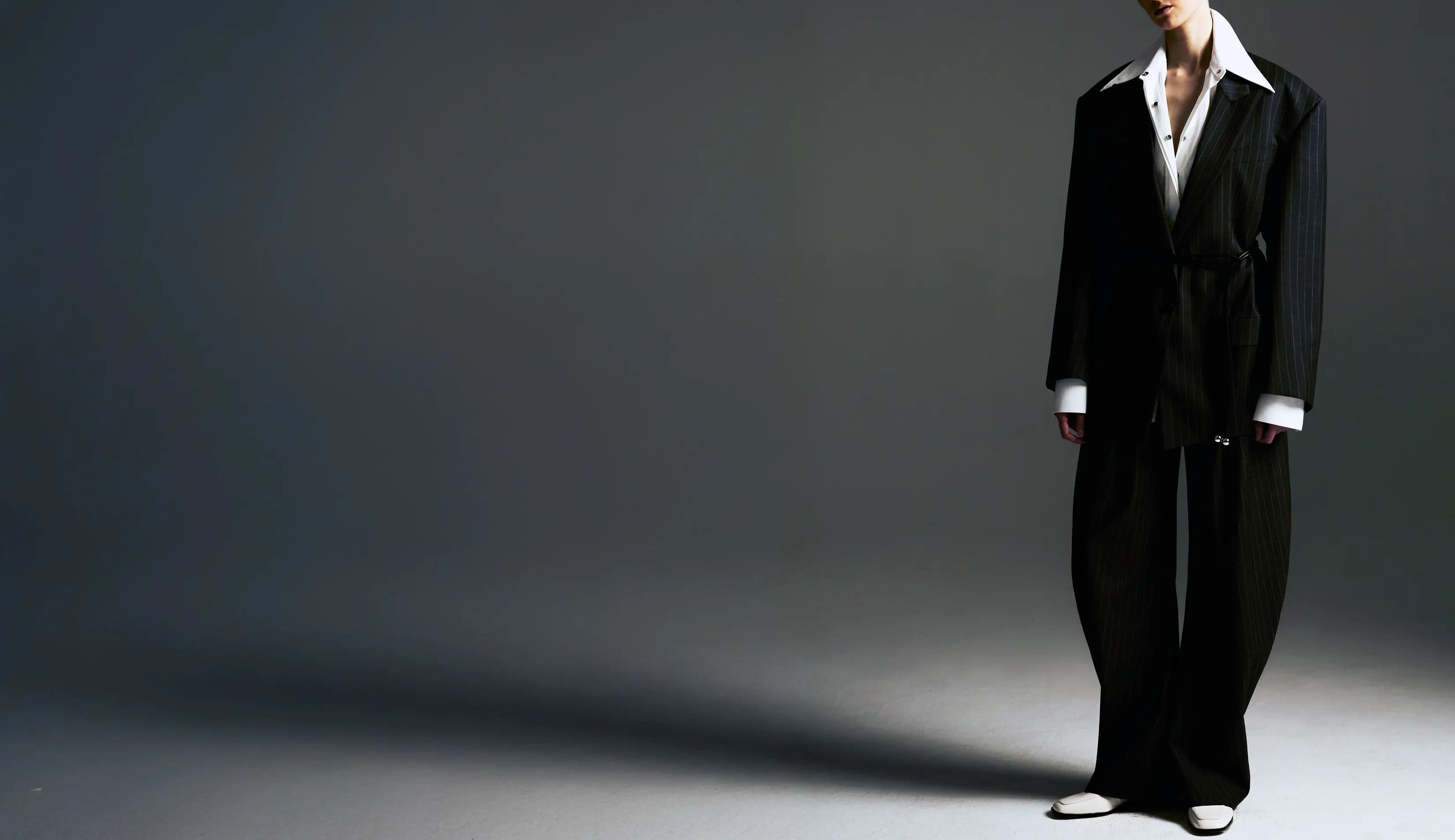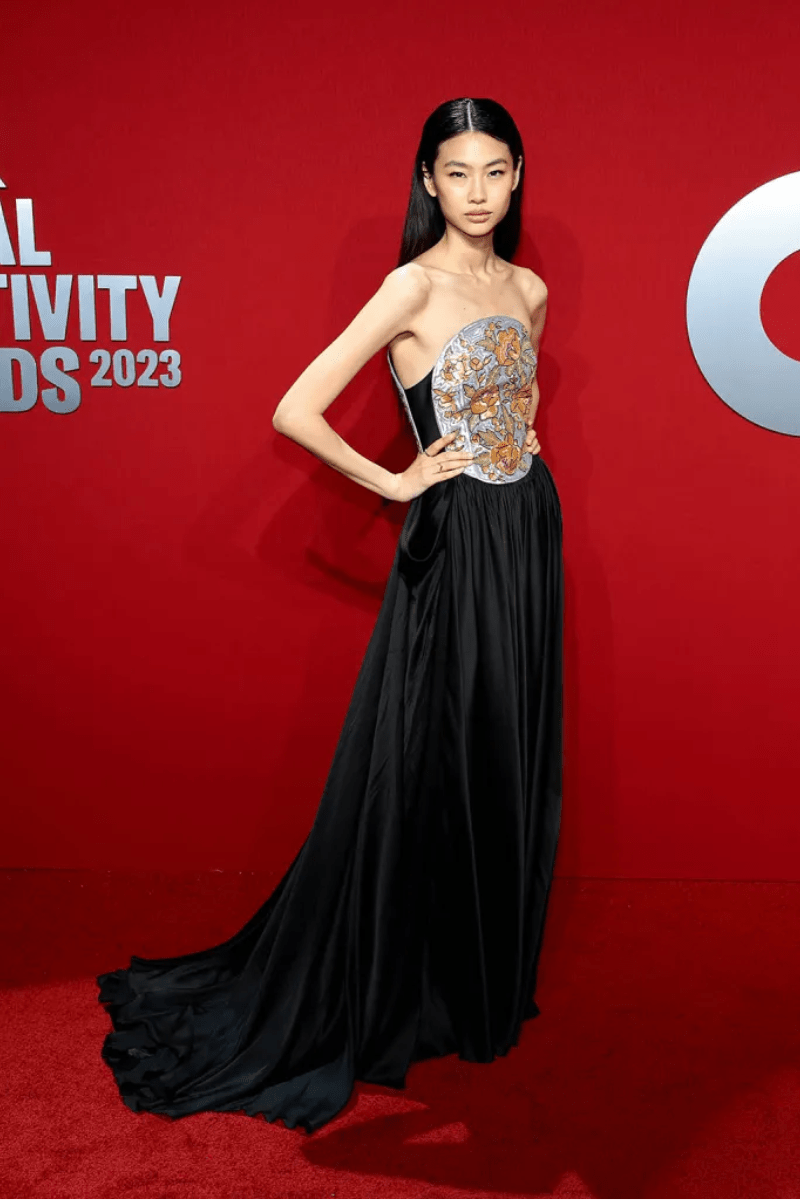Character Construction: Building Authority Through Tailoring Architecture
The technical challenges of creating formal wear that serves character development demand construction expertise that addresses requirements rarely encountered in traditional custom tailoring. Each garment must function within specific narrative contexts while maintaining the sophisticated craftsmanship standards that define quality formal wear, creating engineering problems that require understanding both traditional tailoring principles and contemporary visual communication strategies.
The navy suit visible in the Vincenzo scene demonstrates sophisticated pattern development that creates maximum character impact through strategic construction choices. The shoulder construction requires internal support frameworks that maintain clean lines while accommodating the physical demands of extended filming schedules. The floating canvas technique becomes particularly relevant here—providing invisible structural integrity that supports sophisticated presentation without creating stiffness that might interfere with natural movement or compromise the relaxed confidence that defines the character's professional persona.
The fit philosophy evident in both garments suggests construction approaches that optimize for visual storytelling while maintaining wearability across diverse shooting conditions. The navy suit must communicate executive authority while remaining approachable, requiring pattern-making expertise that balances precise tailoring with subtle ease that prevents the garment from appearing rigid or intimidating. This nuanced approach demands understanding how construction choices contribute to character psychology rather than simply aesthetic appeal.
The blush pink pantsuit construction presents unique engineering challenges that combine traditional formal wear techniques with contemporary professional presentation requirements. The color selection alone requires technical understanding of how specific hues photograph under various lighting conditions while maintaining sophisticated elegance that photographs consistently across different camera angles and post-production processing. The princess seams visible in the jacket construction must accommodate the specific proportional relationships that create feminine authority without compromising professional credibility.
The proportional relationships between both garments also require mathematical precision that differs from conventional formal wear applications. Creating visual harmony between characters with different roles and personality types demands understanding how individual construction choices contribute to ensemble presentation while maintaining the personal distinction that prevents uniform-like homogenization. This balance requires armscye-level attention to detail that ensures optimal fit for each individual while serving broader narrative requirements.
The internal construction must accommodate the performance demands that characterize television production. Extended wearing periods, dynamic movement for action sequences, and frequent costume changes require construction techniques that prioritize both visual consistency and practical durability under conditions that exceed normal formal wear expectations. The canvassing applications must provide sufficient structure to maintain intended silhouettes while ensuring comfort during intensive filming schedules.
Color Psychology: Technical Execution of Character Communication
The intersection of color theory with character development creates construction challenges that require sophisticated understanding of both traditional tailoring principles and contemporary psychological communication strategies. Successful K-Drama formal wear combines technical color execution with strategic character development through fabric selection and construction applications.
The navy selection for the male character demonstrates technical mastery that extends past simple aesthetic coordination. Creating garments in navy requires understanding how this specific color interacts with different fabric constructions and lighting conditions while serving character psychology goals. Navy's authority associations must be balanced with approachability factors that prevent the character from appearing intimidating or inaccessible to audience engagement. This color-psychology synthesis requires advanced fabric selection that accounts for how navy appears under television production lighting while maintaining sophisticated appeal in various narrative contexts.
The blush pink choice for the female character represents strategic color thinking that challenges traditional professional wear conventions while maintaining sophisticated credibility. Pink's historical associations with femininity must be carefully balanced with professional authority requirements through construction techniques that emphasize architectural precision over decorative elements. The technical challenge involves achieving color impact that serves character development while ensuring the garment maintains professional appropriateness across different narrative situations.
The lighting interaction considerations also influence construction decisions in ways that don't typically affect custom tailoring. Different colors respond unpredictably to television production lighting, potentially creating visual effects that interfere with intended character communication. Construction techniques must account for how these specific colors will appear under studio lighting, location filming conditions, and post-production color correction while maintaining consistent character messaging across all viewing contexts.
The surface treatment applications require specialized construction approaches that accommodate both color integrity and structural durability. The navy suit must maintain color consistency through multiple filming days and potential weather exposure, while the pink pantsuit requires construction that prevents color bleeding or surface degradation while ensuring the underlying garment construction maintains its intended fit and professional appearance. This technical challenge requires understanding both advanced fabric science and traditional tailoring durability principles.
The seasonal adaptation requirements for character wardrobes also influence construction philosophy toward versatility and narrative consistency. Character development must remain coherent across different episodes and seasonal contexts, requiring construction techniques that can accommodate minor modifications or layering variations without compromising overall character visual identity. This adaptability demands engineering approaches that prioritize both aesthetic consistency and practical functionality across extended production schedules.
Professional Translation: Adapting Screen Authority for Real-World Application
The process of translating K-Drama formal wear elements into custom tailoring applications requires technical expertise that bridges entertainment industry construction techniques with traditional formal wear quality standards. Successful adaptation maintains the visual authority that creates character impact while ensuring wearability and craftsmanship appropriate for professional investment applications.
The navy suit construction visible in Vincenzo requires advanced pattern-making skills that can recreate executive presence while adapting proportions for different body types and professional contexts. The internal support structures necessary for television presentation must be modified for real-world professional wear that prioritizes comfort during extended business activities over visual impact optimization. This adaptation requires understanding both entertainment industry construction techniques and contemporary professional wear requirements.
The blush pink pantsuit translation presents unique challenges that involve adapting color boldness for professional environments while maintaining the sophisticated authority that defines the original character presentation. The construction modifications required for business contexts must preserve the architectural precision that creates visual impact while ensuring appropriate professional presentation across diverse workplace cultures and expectations. This translation process requires advanced understanding of both color psychology applications and professional wear construction standards.
The proportional scaling required for real-world adaptation also presents technical challenges that don't exist in entertainment industry applications. Construction elements that create optimal visual impact on screen might require mathematical adjustments to translate effectively for different body proportions and professional usage requirements. This scaling expertise requires understanding both construction mathematics and professional psychology that drives effective business presentation.
The durability requirements for professional applications also differ significantly from entertainment industry standards. K-Drama formal wear often prioritizes immediate visual impact over extended wear expectations, requiring construction modifications that maintain aesthetic appeal while ensuring longevity appropriate for professional wardrobe investment. This durability adaptation requires advanced understanding of both construction techniques and material science applications.
The cost considerations for professional adaptation also influence construction decisions in ways that require balancing visual impact with business accessibility. Entertainment industry construction budgets often support techniques and materials that might not be economically viable for professional applications, requiring creative problem-solving that maintains character authority while ensuring reasonable pricing for sophisticated clients seeking executive presence enhancement.
Cultural Integration: Korean Formal Aesthetics Within International Professional Contexts
The strategic application of Korean formal wear principles to international professional wardrobing creates opportunities for sophisticated clients to achieve visual authority that communicates cultural intelligence while maintaining professional credibility within diverse business environments. This integration process requires understanding both Korean aesthetic traditions and contemporary international professional expectations.
The Korean approach to professional presentation visible in K-Drama formal wear demonstrates construction philosophies that differ from traditional Western business attire standards, particularly in areas of color application, proportional relationships, and the balance between personal expression and professional conformity. These cultural differences create opportunities for professional distinction that serves clients seeking alternatives to conventional business dress while maintaining sophisticated credibility.
The color palette strategies developed for K-Drama applications also translate effectively to professional wardrobe development. Korean formal wear often incorporates colors and combinations that differ from traditional Western business standards, providing distinctive options for professionals seeking visual authority that communicates cultural sophistication and contemporary awareness. The blush pink pantsuit demonstrates how non-traditional professional colors can maintain authority when executed with appropriate construction sophistication.
The fit philosophy adaptations from Korean formal wear also benefit professional applications. Korean garment construction often emphasizes comfort and natural movement in ways that complement contemporary professional lifestyle requirements while maintaining sophisticated visual presentation. These construction approaches serve professionals seeking formal wear that accommodates demanding schedules and diverse professional activities while maintaining executive presence.
The layering coordination techniques visible in K-Drama styling also translate to professional applications. Understanding how different garment constructions interact in professional presentations enables sophisticated accessory integration and seasonal adaptation while maintaining overall professional coherence. This technical knowledge creates wardrobe versatility that maximizes investment value while serving diverse professional occasion requirements.
The quality indicators emphasized in Korean formal construction also inform professional wardrobe standards. K-Drama formal wear often demonstrates construction excellence through subtle details and superior finishing that communicate sophistication without obvious display. These quality approaches benefit professional applications by providing distinction markers that communicate executive status through craftsmanship rather than brand positioning.
Construction Innovation Through Screen Translation
The synthesis of entertainment industry construction techniques with traditional custom tailoring generates technical innovations that expand professional formal wear possibilities while maintaining sophisticated craftsmanship standards. These innovations often emerge from necessity of solving problems that don't exist when working within conventional tailoring frameworks, creating solutions that benefit both character communication and professional presentation objectives.
One significant innovation involves adaptive construction techniques that allow formal wear to serve multiple professional contexts while maintaining construction quality and visual authority. K-Drama formal wear often requires versatility across different narrative situations, generating construction approaches that enable garments to function effectively in diverse professional environments without obvious modification or alteration requirements.
The integration of performance considerations within formal construction represents another area of innovation driven by K-Drama requirements. Traditional formal wear often prioritizes static presentation over dynamic functionality, but entertainment industry applications require construction that maintains sophisticated appearance through extended wear and varied physical activities. This performance integration benefits professional applications by providing enhanced comfort and durability while maintaining formal presentation standards.
The color integration strategies developed for character communication also benefit professional custom tailoring services. Successfully incorporating non-traditional colors within formal wear contexts requires technical expertise that can execute sophisticated color relationships while maintaining professional appropriateness and construction quality. These color technologies provide customization options that serve professionals seeking distinctive formal wear solutions that reference contemporary cultural influences.
The documentation and reproduction innovations required for entertainment consistency also advance custom tailoring capabilities. Creating formal wear that maintains character coherence across multiple episodes and production phases requires systematic approaches that ensure construction consistency while accommodating individual modifications and character development. These documentation systems benefit custom tailoring operations seeking to provide comprehensive professional wardrobing that maintains aesthetic coherence across different business contexts.
The fitting technologies developed for entertainment applications also offer advantages for contemporary custom tailoring operations. Managing character development requirements and narrative consistency demands fitting approaches that maintain precision while accommodating systematic relationships between different garments and professional presentation goals. These technical innovations benefit custom tailoring services seeking to provide executive wardrobing that serves sophisticated professionals with complex presentation requirements.
Market Implications: Screen Influence as Professional Differentiation
The influence of K-Drama formal wear on professional wardrobe expectations creates economic opportunities for sophisticated custom tailoring operations that understand how to translate entertainment industry innovations into professional services. This cultural intelligence provides competitive differentiation that commands premium pricing while serving contemporary professional preferences shaped by global cultural consumption and sophisticated aesthetic awareness.
The technical expertise required for entertainment-influenced formal wear development represents advanced skills that merit compensation reflecting specialized knowledge and cultural sophistication. Professionals seeking formal wear solutions that demonstrate cultural intelligence while maintaining construction quality often value the entertainment translation expertise and technical innovation required for successful execution of these distinctive professional presentation strategies.
The customization opportunities created by screen influence approaches provide service differentiation that distinguishes sophisticated tailoring operations from conventional business wear providers. Offering formal wear planning services that demonstrate understanding of character communication principles and sophisticated aesthetic coordination creates unique value propositions that serve culturally intelligent professionals seeking distinctive formal wear solutions that reflect international awareness and contemporary sophistication.
The market positioning opportunities created by expertise in entertainment translation provide competitive advantages for tailoring operations that understand how to communicate these capabilities to appropriate professional segments. The growing appreciation for cultural intelligence in business contexts creates market demand for services that demonstrate authentic understanding of global aesthetic influences and their practical applications to professional presentation strategy.
The collaboration opportunities with related service providers—image consultants, executive coaches, entertainment industry professionals—create business development possibilities for tailoring operations that demonstrate expertise in entertainment-influenced professional development. These cultural competencies create networking and referral opportunities that expand market reach while establishing thought leadership in culturally intelligent professional services.
The educational and content marketing opportunities created by expertise in screen translation provide thought leadership platforms that establish market authority and attract sophisticated professionals. Demonstrating understanding of how entertainment industry innovations influence contemporary professional presentation creates credibility that supports premium positioning while contributing to broader industry discourse about cultural intelligence in executive wardrobing.
Future Trajectories: Where Screen Influence Shapes Professional Evolution
The technical innovations emerging from K-Drama formal wear applications suggest several evolutionary directions that could influence broader professional presentation approaches. These developments represent fundamental shifts in how sophisticated professionals approach formal wear planning and executive presence strategy rather than simply aesthetic trend adoption.
Sustainability considerations increasingly influence both entertainment production and professional wardrobing. The systematic thinking that drives character development through costume design aligns with contemporary environmental values emphasizing wardrobe longevity and multi-functional design over frequent replacement and single-use professional wear. The construction techniques developed for entertainment applications often exceed traditional custom tailoring standards for adaptability and modification potential.
Technology integration will likely accelerate in both entertainment design and professional styling applications, with digital visualization tools and virtual fitting methods becoming more sophisticated and accessible. The character development requirements that drive K-Drama innovation create opportunities for custom tailoring operations to develop professional communication tools that facilitate executive wardrobing while maintaining construction quality and individual customization.
The globalization of professional aesthetic preferences will likely continue expanding, with innovations from entertainment applications influencing broader business presentation approaches. This cultural cross-pollination creates opportunities for technical advancement that draws from diverse professional traditions while serving contemporary business requirements that increasingly involve multiple cultural contexts and international presentation demands.
Cultural synthesis in professional styling will likely continue evolving, with Korean innovations influencing professional presentation approaches while traditional luxury tailoring techniques contribute to hybrid approaches that serve internationally sophisticated business leaders. This synthesis creates opportunities for technical innovation that honors both cultural intelligence and traditional craftsmanship while meeting contemporary professional sophistication requirements.
The relationship between entertainment industry innovation and professional styling will probably deepen, with character development techniques finding broader utility in executive wardrobing, leadership presentation, and corporate communication markets. The systematic thinking that drives entertainment costume design addresses challenges that exist across multiple professional presentation categories in contemporary international business contexts.
Conclusion: Screen Sophistication as Professional Evolution
The construction precision visible in Vincenzo's formal wear demonstrates how entertainment industry expertise can inform rather than compromise sophisticated professional presentation. The technical innovations required for creating formal wear that serves both character development and executive presence offer valuable insights for custom tailoring operations seeking to serve contemporary professionals whose presentation requirements involve both aesthetic sophistication and cultural intelligence.
The market opportunities created by screen influence extend past entertainment industry applications to encompass fundamental shifts in professional expectations for cultural awareness, technical innovation, and global aesthetic fluency. Custom tailoring operations that understand how to translate entertainment industry innovations into professional services gain competitive advantages that justify premium positioning while serving contemporary business navigation requirements.
The technical foundations established through entertainment industry construction provide valuable precedents for addressing professional presentation challenges that require balancing individual expression with business appropriateness. The construction approaches developed for character communication often exceed traditional custom tailoring standards for versatility, cultural intelligence, and sophisticated construction—qualities that benefit any professional application requiring contemporary relevance and international credibility.
As professional presentation continues evolving in response to culturally influenced expectations and global business requirements, the innovations driven by K-Drama formal wear offer models for creating professional wardrobes that serve contemporary business communication demands while maintaining the craftsmanship standards and visual sophistication that justify custom tailoring investment. The systematic precision required for successful character translation suggests that the most enduring professional presentation innovations will emerge from thoughtful engagement with cultural influences rather than superficial trend adoption or reactive business dress approaches.



